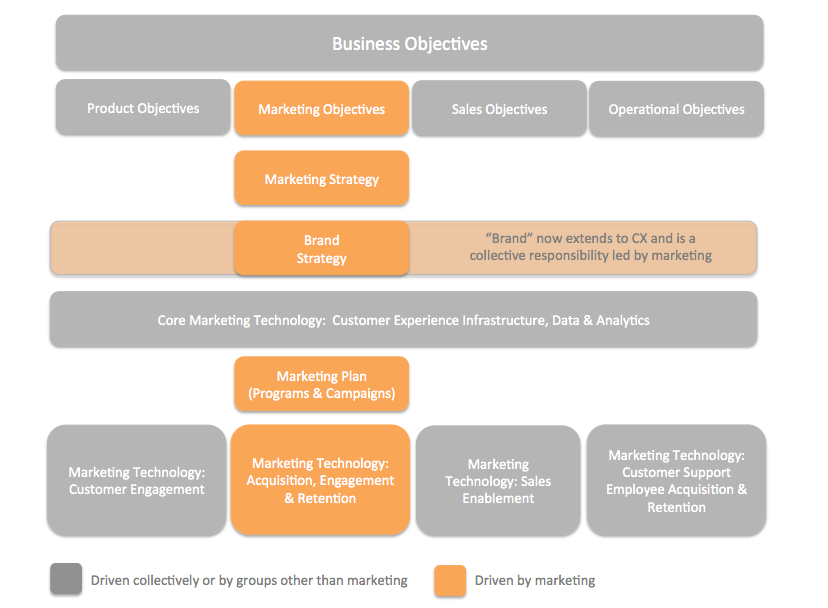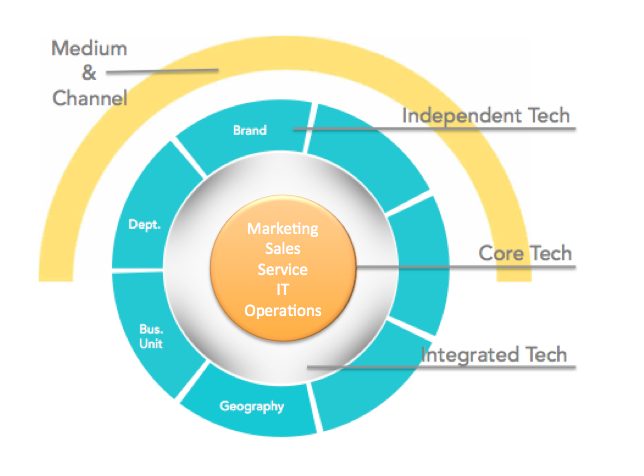How to drive digital transformation strategy in a rapidly evolving technology environment
Vote for this entry in the 2017 Hackie Awards by sharing it on Facebook, Linkedin or Twitter by May 1.
 This article is a guest post by Anita Brearton of CabinetM. It was entered into The Hackies essay contest for the upcoming MarTech conference. Like it? You can register your vote in the contest by sharing it on social media, especially LinkedIn, Facebook, and Twitter.
This article is a guest post by Anita Brearton of CabinetM. It was entered into The Hackies essay contest for the upcoming MarTech conference. Like it? You can register your vote in the contest by sharing it on social media, especially LinkedIn, Facebook, and Twitter.
Last month, I listened to a webinar presentation related to the disruptions ahead in marketing technology. Two of the topics, the democratization of marketing and ownership of the customer experience, resonated deeply and are key issues to be addressed in managing a digital transformation strategy.
Over the last two years at CabinetM, we’ve spent a lot of time with enterprise marketing teams talking about the challenges of digital transformation. Here’s what we’ve learned:
- Digital transformation is seen as the key to delivering both a unified customer experience and a quality of service and interaction that will differentiate the company in their competitive landscape.
- The companies we’ve talked to believe that they are behind in their transformation efforts in comparison to their competitors. We haven’t met with anyone yet that has proudly said they are at the forefront of digital transformation.
- Companies are working hard to develop and layer a CX and digital transformation strategy on top of an already complex internal marketing technology environment. In the absence of a centralized strategy and with a technology landscape that makes it easy to purchase and experiment with new technology, marketing teams have deployed hundreds of new products across the enterprise to acquire, engage, and retain customers and are struggling to manage what they have while at the same time create a rational plan for going forward.The democratization of marketing is well underway. Low cost SaaS-based products have made it easy for anyone to acquire marketing technology and today it’s not uncommon to see virtually every department in the company acquiring bits and pieces of marketing technology in support of creating a better customer experience. The challenge is that without an overarching strategy companies are in essence creating a marketing orchestra without a conductor in place to ensure that everyone is playing together in harmony and creating a wonderful listening experience for the audience! As a result, digital transformation efforts are underway but are not necessarily yielding the unified customer experience results that companies are striving for.
- Companies already on the digital transformation path have come to realize that this is not a single discrete exercise — with the pace of technology evolution and shifting trends in marketing there will never be that glorious moment when the marketing team will be able to shout “DONE!”
Given all the challenges how do you drive digital transformation and achieve your unified customer experience objectives?
The magic is in creating an executable plan that is easily adaptable to changing marketing and technology trends supported by an organizational structure that ensures centralized decision-making where necessary, and distributes decision-making where possible to promote innovation and evolution.
At the risk of stating the obvious, it starts with business strategy. Product, service and sales goals provide the basic framework and necessary information to support the definition of customer experience objectives and the executive team is the starting point for organizational alignment.
Who should be defining and leading the CX strategy?
Is it the product or marketing team? For mobile and online businesses it would be easy to cede that responsibility to the product team, since so much of the actual customer experience comes from the use of the product itself or how the customer buys the product. It is the product team that generally drives and tests the product and purchasing experience that represent the biggest pieces of the CX puzzle.
But they are not the entire puzzle; a unified customer experience involves all departments and all touch points with a company, both online and offline, and as such is perhaps the most critical component of an overall brand strategy in today’s market environment.
Marketing is the brand steward, and in the same way that marketing works to define a brand’s look and feel, tone and attributes, they should also be working across the organization to define and manage the overall experience each customer has with every touch point in the company and through every device they use to reach into the organization.
CX objectives shouldn’t be created in isolation by marketing; they should be developed with the involvement of all key functional representatives and approved by the executive team as part of the overall marketing and branding strategy.
With objectives in place, every department has their own role to play in serving the brand CX goals. For the product team the CX goals roll into the product experience strategy and development plan. For marketing, sales, service, finance and IT, it is more complicated, since each department has a role to play in customer acquisition, engagement and retention, that isn’t always easily defined along functional lines.
Additionally, in order to be effective in driving a unified CX experience, these departments need a complete picture of each customer and a shared customer data set to ensure that everyone is operating from the same base of knowledge — a single source of truth if you will.

There are some big decisions to make about managing, integrating and analyzing customer data as well as the technology a company will use to interact with its customers. Is this marketing’s responsibility?
Given that decisions in these technology categories will affect every department’s ability to support CX objectives, for most companies this will need to be a shared responsibility with technology selection led or co-led by the IT department.
An increasingly common approach to marketing technology strategy is to create a marketing technology stratification that provides a framework for defining the organizational process around the technology decisions and purchasing.
A simple approach to this is to designate technology as core infrastructure (technology that touches every department), an integrated edge product (tools that integrate with the core platforms and are used by one or more departments), or independent point products that operate in a standalone fashion (typically team or program specific).
A stratified approach to technology strategy makes it easy to introduce process, discipline and structure around purchasing where necessary (core platforms), and at the same time support the democratization of technology acquisition for edge and point products allowing teams to move quickly to test and try innovative new technology.

Regardless of where a new tool or piece of technology fits in the overall landscape, it is it is important to ensure that it is visible across the organization for a number of reasons:
- To manage the security risk of implementing new technology that accidentally exposes or corrupts customer data.
- To enable teams to learn from each other’s experience with any given technology and to increase efficiency by distributing product qualification tasks.
- To reduce spend by identifying redundant products or opportunities to lower spend by negotiating a single contract for the enterprise.
This is where the marketing stack comes in. Marketing stacks showcase the technology in use across the organization and their relationship to one another. Stacks can be developed at the project, team, functional or enterprise level. They can be used to track products in use, in test and that have been retired.
There’s no right or wrong way to construct a stack — each stack ends up being unique to the organization and the objectives it serves. You just have to look at the Stackies submissions for the last two years to see how unique stacks can be. Stacks are a great way to audit and manage the technology in place and ensure technology visibility across the enterprise.

Driving a unified customer experience and digital transformation is continuing initiative not a discrete project.
It would be nice if we could start with a clean slate but for most of us that’s not practical, we’re moving at a million miles per hour, we have teams across the enterprise already buying and implementing marketing technology, we’re saddled with large systems that are already in place not to mention a ton of hidden internally developed technology and integration code.
So how do we interject strategy and coordination into the hectic and challenging environment?
- Define your CX goals against your corporate business goals.
- Obtain conceptual buy-in from the executive team.
- Identify key constituents across the organization that are buyers and users of marketing technology — form a cross-functional team or working group to set policy and technology objectives that align with your CX goals.
- Translate your CX goals into a technology strategy and plan:
- Figure what you already have – audit your technology across the organization by building your stacks. Make sure you include acquired technology, internally developed technology and any technology that is acquired and implemented on your behalf by your agencies.
- Share your stacks across the enterprise and identify redundant products that can be replaced. Identify products that are not performing or no longer in use. Get rid of them. Identify internal technology, which is hard to track, and can easily become stale that can be replaced by off the shelf technology.
- Decide what makes sense for your organization in terms of marketing technology stratification and the process for buying, implementing and managing technology.
- Focus your immediate efforts on making sure that you have the right core platforms — start with a data management platform. Once you have a functioning single source of comprehensive customer data you can start thinking about things like omni-channel personalization. Prioritize the acquisition of big platforms. One step at a time.
- As you qualify core platforms explore what benefits can be derived through integration with other platforms and program specific tools. Integrate where it makes sense.
- Empower teams to test and try new technology and give them the tools to share the results across the organization.
- Review progress with the organization quarterly and course correct as necessary.
And finally, keep going. Digital transformation is a daunting task for most organizations but like most things once you get started it becomes easier and easier to prioritize the most important elements.
If you don’t have the resources or skills internally then reach out to find an agency partner. Many agencies and the large consulting practices are developing skills and programs to support digital transformation.
With a little discipline and strategy you’ll soon find that you are no longer just reacting to internal and market demands but are instead able to proactively anticipate and prioritize technology needs.
About the author
Anita Brearton is founder and CEO of CabinetM. She is an experienced start-up executive, skilled at addressing the strategic operational and marketing challenges faced by high growth, early stage businesses. In 2014, Anita and Sheryl Schultz founded CabinetM, a technology discovery and management platform to help marketing teams manage the technology they have and quickly navigate the complex marketing technology landscape to find the best digital tools for any marketing campaign, program or engagement effort.
Prior to CabinetM, Anita served as the executive chairman of FashionPlaytes, an online fashion and style destination for tween girls. She serves on the board of MassVentures as vice chairman and is a member of the Golden Seeds angel group. She has also worked with many startups as a marketing and strategy consultant, helping shape go-to- market strategies that enabled her clients to achieve their marketing and business goals. Anita has participated as a judge in the MassChallenge and MIT 100K business plan competitions, served as board director for the Angel Capital Association and The Sunflower Initiative, and was an executive in residence at Simmons College. Anita speaks frequently on marketing practices and stack building.
What did you think of this article as an entry in The Hackies essay contest for the upcoming MarTech conference? If you liked it, you can register your vote in the contest by sharing it on LinkedIn, Facebook, and Twitter.
Contributing authors are invited to create content for MarTech and are chosen for their expertise and contribution to the search community. Our contributors work under the oversight of the editorial staff and contributions are checked for quality and relevance to our readers. MarTech is owned by Semrush. Contributor was not asked to make any direct or indirect mentions of Semrush. The opinions they express are their own.
Related stories
New on MarTech